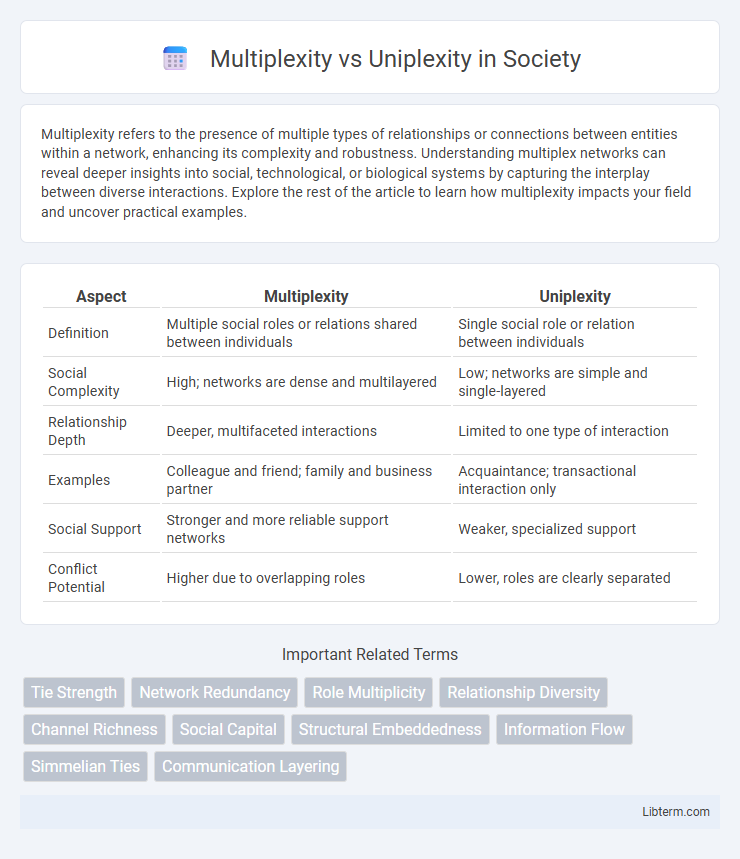Multiplexity refers to the presence of multiple types of relationships or connections between entities within a network, enhancing its complexity and robustness. Understanding multiplex networks can reveal deeper insights into social, technological, or biological systems by capturing the interplay between diverse interactions. Explore the rest of the article to learn how multiplexity impacts your field and uncover practical examples.
Table of Comparison
| Aspect | Multiplexity | Uniplexity |
|---|---|---|
| Definition | Multiple social roles or relations shared between individuals | Single social role or relation between individuals |
| Social Complexity | High; networks are dense and multilayered | Low; networks are simple and single-layered |
| Relationship Depth | Deeper, multifaceted interactions | Limited to one type of interaction |
| Examples | Colleague and friend; family and business partner | Acquaintance; transactional interaction only |
| Social Support | Stronger and more reliable support networks | Weaker, specialized support |
| Conflict Potential | Higher due to overlapping roles | Lower, roles are clearly separated |
Introduction to Multiplexity and Uniplexity
Multiplexity refers to the presence of multiple types of relationships or connections between the same entities within a social network, enhancing the complexity and depth of interactions. Uniplexity, by contrast, involves a single type of relationship between entities, offering a more straightforward and less interconnected network structure. Understanding the dynamics of multiplexity versus uniplexity is crucial for analyzing social behaviors, communication patterns, and network robustness in fields such as sociology, communication studies, and network science.
Defining Multiplexity in Relationships
Multiplexity in relationships refers to the presence of multiple types of connections or interactions between individuals, such as combining friendship, colleagueship, and family ties within one bond. Unlike uniplex relationships, which involve a single type of interaction or role, multiplex relationships are characterized by their layered social functions, enhancing social support and information flow. Research in social network analysis shows that multiplex ties often result in stronger, more resilient connections due to the intertwined nature of roles and shared activities.
Understanding Uniplexity: The Single-Tie Connection
Uniplexity refers to social relationships characterized by a single type of connection between individuals, such as a tie solely based on friendship or work. These single-tie connections tend to be more specialized and have limited overlap in social functions, influencing the flow of information and support within networks. Understanding uniplexity helps in analyzing the degree of relationship multiplexing and its impact on social cohesion and resource accessibility.
Key Differences Between Multiplexity and Uniplexity
Multiplexity refers to the presence of multiple types of relationships or connections between the same entities, whereas uniplexity involves a single type of relationship. Key differences include the complexity and depth of social ties, with multiplex relationships often indicating stronger, multifaceted connections compared to the simpler, singular connections in uniplex networks. Understanding these distinctions is crucial for analyzing social network dynamics, communication patterns, and community structures.
Theoretical Foundations of Multiplex and Uniplex Ties
Multiplexity refers to social ties that encompass multiple types of relationships between the same actors, such as friendship, work, and family connections, enhancing relational complexity and resource exchange potential. Uniplex ties, by contrast, involve a single relational context, limiting the scope of interaction and influence. Theoretical foundations draw from Granovetter's strength of weak ties and Burt's structural holes, highlighting how multiplex ties foster stronger social cohesion and trust, whereas uniplex ties serve more specialized functions within social networks.
Benefits and Challenges of Multiplex Relationships
Multiplex relationships, characterized by multiple types of interactions between the same individuals, foster deeper trust, increased social support, and enhanced resource sharing compared to uniplex relationships that involve a single type of connection. These multifaceted ties contribute to stronger social cohesion and greater resilience during crises, yet they also present challenges such as role conflict, blurred boundaries, and increased emotional labor. Effectively managing multiplex relationships requires balancing overlapping social roles while leveraging their benefits for collaborative problem-solving and sustained interpersonal influence.
Advantages and Limitations of Uniplex Connections
Uniplex connections, defined by single-type relationships between entities, offer the advantage of simplicity and ease in data analysis, allowing for straightforward interpretation and reduced computational complexity. These connections, however, limit the scope of network insights by excluding multi-dimensional interactions characteristic of multiplex networks, which can restrict understanding of complex relational dynamics. Despite their constrained perspective, uniplex connections are beneficial for focused studies where clear, singular relationship types are essential, facilitating targeted network modeling and hypothesis testing.
Real-World Examples of Multiplexity and Uniplexity
Multiplexity refers to relationships where individuals engage through multiple social roles, such as coworkers who are also close friends, exemplified by colleagues who collaborate professionally and socialize outside work. Uniplexity involves single-role connections, like a customer and a cashier who interact solely for transactional purposes without further social bonding. Real-world examples of multiplexity include family members who are also business partners, while uniplexity is common among acquaintances in large organizations where interactions are limited to specific contexts.
Impact of Multiplexity vs Uniplexity on Social Networks
Multiplexity in social networks, characterized by multiple types of relationships between the same individuals, enhances network resilience, trust, and information flow compared to uniplexity, where only single-type connections exist. Multiplex ties facilitate stronger social cohesion and more reliable support systems, contributing to greater resource access and collaboration opportunities within the network. In contrast, uniplex networks often suffer from weaker trust and limited communication channels, reducing overall social capital and network effectiveness.
Future Research Directions in Tie Strength and Relationship Types
Future research on tie strength and relationship types should explore the dynamic interplay between multiplexity and uniplexity in social networks, emphasizing how multiple interaction channels influence tie durability and information diffusion. Investigating contextual variations in multiplex ties across digital and offline environments can reveal nuanced patterns of social influence and support mechanisms. Leveraging advanced computational models and big data analytics will enhance the understanding of how multiplex relationships impact social cohesion and individual well-being over time.
Multiplexity Infographic

 libterm.com
libterm.com